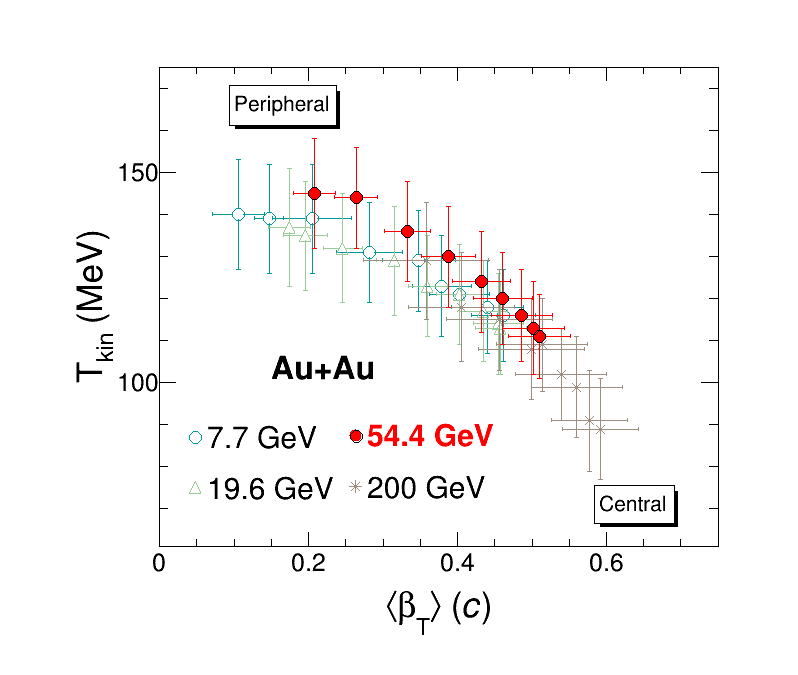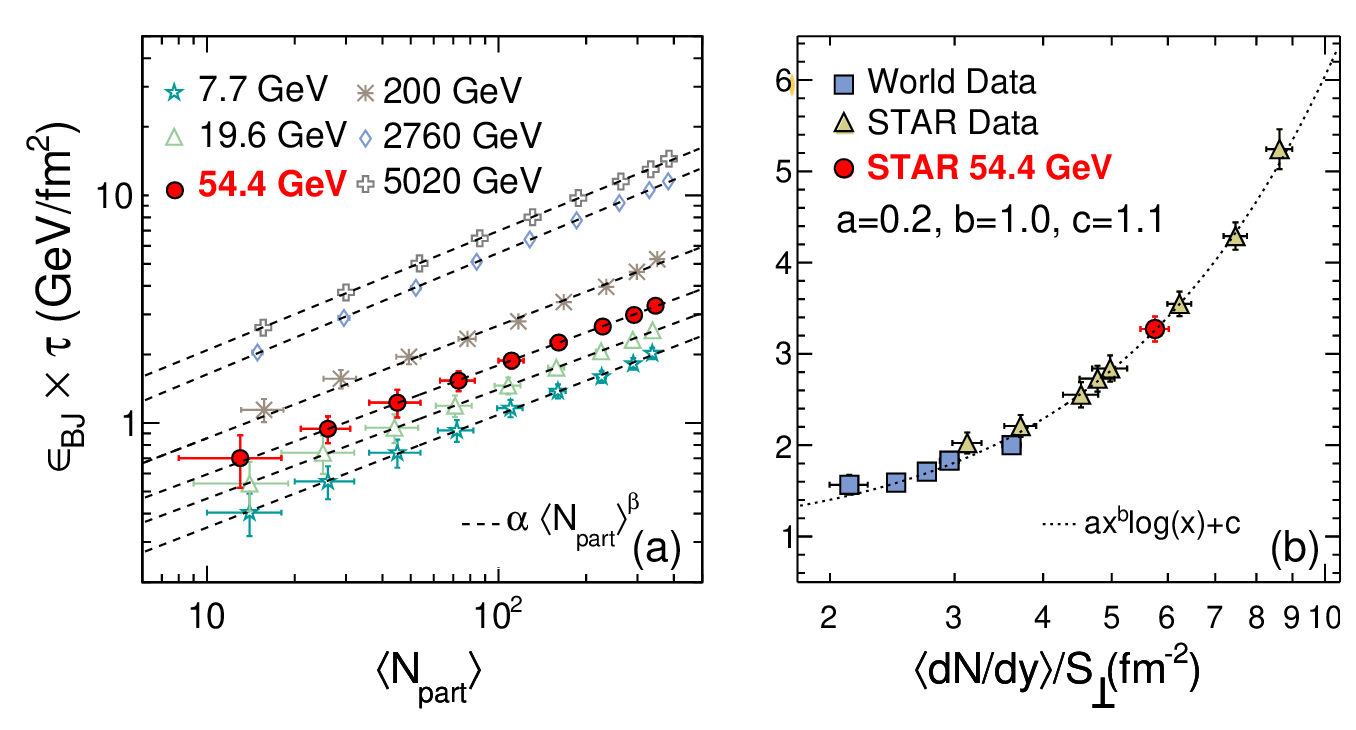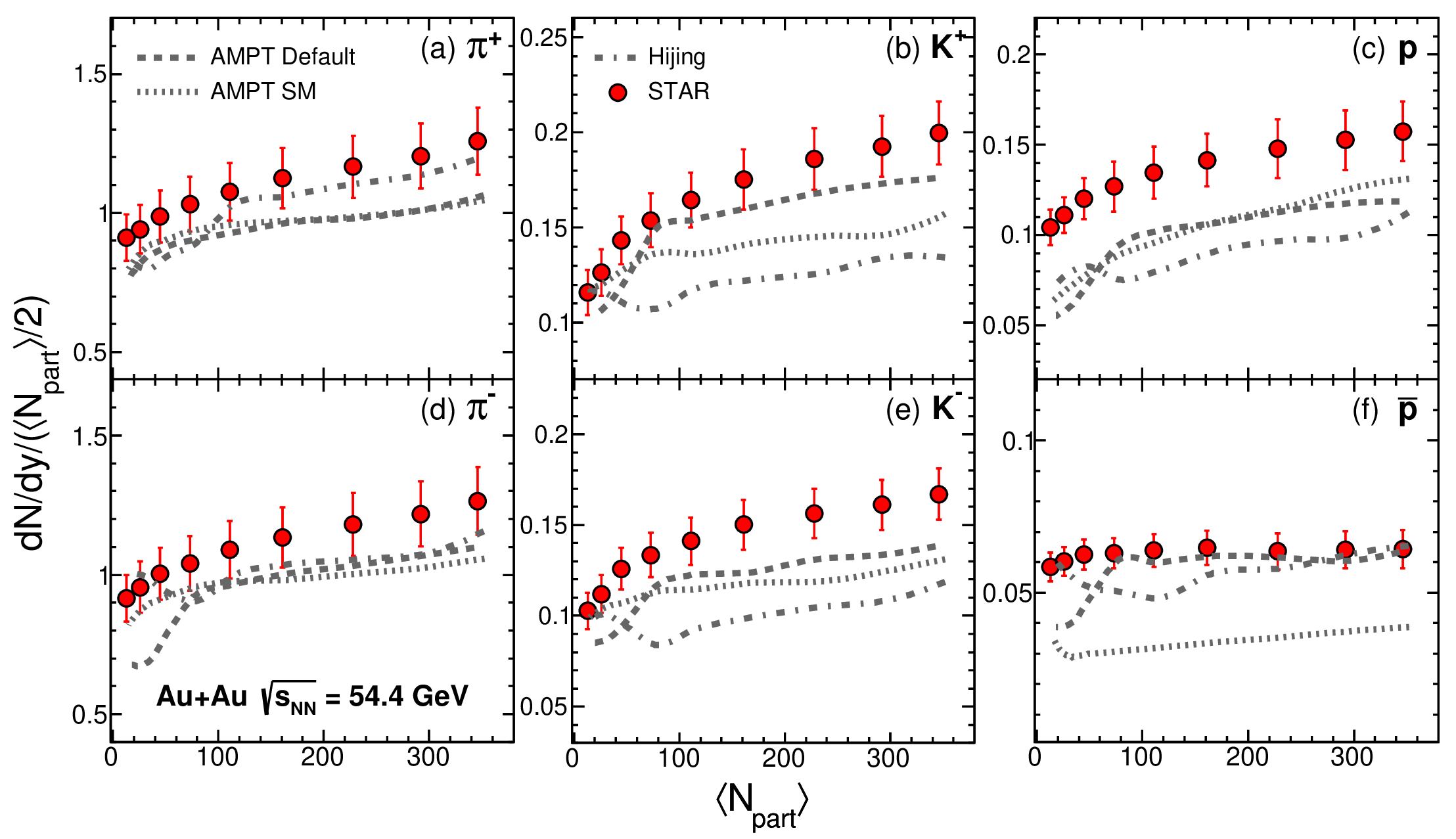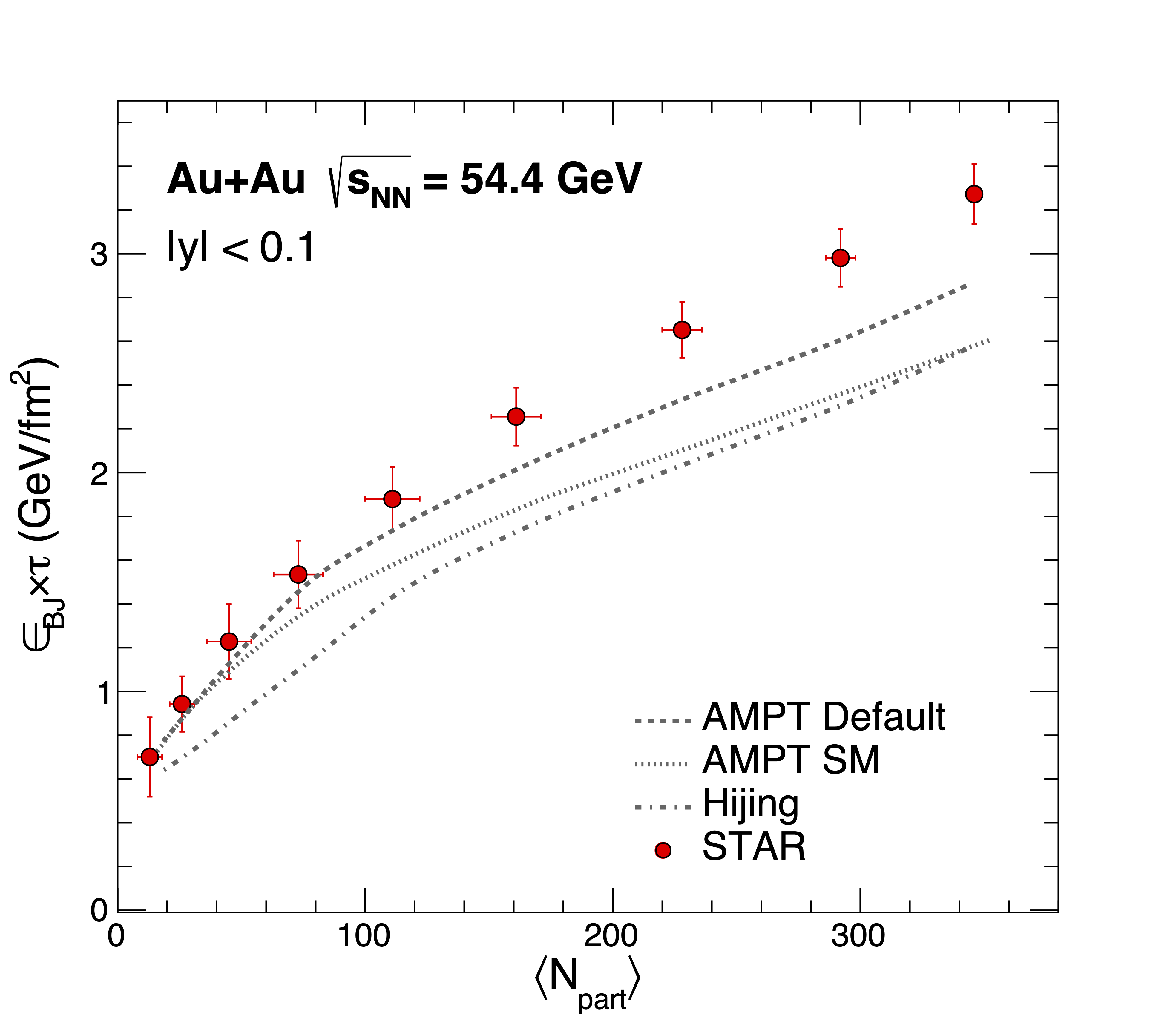Paper Proposal
General Information:-
- Paper title: Identified charged hadron production in Au+Au collisions at $\sqrt{s_{NN}}$ = 54.4 GeV with STAR detector
- PAs: Arushi Dhamija [1], Krishan Gopal [2], Chitrasen Jena [2], Lokesh Kumar [1], Natasha Sharma [3]
[2]: Indian Institute of Science Education and Research (IISER) Tirupati, Tirupati 517507, India
[3]: Indian Institute of Science Education and Research (IISER) Berhampur, 760010, India
- Target journal: Phys. Rev. C
Abstract:-
We present results on the production of $\pi^{\pm}$, $K^{\pm}$, $p$, and $\bar{p}$ particles in Au+Au collisions at $\sqrt{s_\mathrm{NN}}$ = 54.4 GeV using the STAR detector of RHIC at mid-rapidity ($|y| <$ 0.1). Invariant yields of these particles as a function of transverse momentum are presented. We determine bulk properties, such as particle yields ($dN/dy$), mean transverse momentum ($\langle p_{T} \rangle$), particle ratios, etc., that provide insight into the particle production mechanisms. Additionally, the kinetic freeze-out parameters ($T_\text{kin}$ and $\langle \beta \rangle$) provide information about the dynamics of the system at the time of freeze-out are obtained. The Bjorken energy density ($\epsilon_{BJ}$), gives an estimate of the energy density of the central rapidity region in the collision zone at the formation time $\tau$, is calculated and compared as a function of multiplicity for various energies. The results are compared with the models such as A Multi-Phase Transport (AMPT) and Heavy Ion Jet INteraction Generator (HIJING) for further understanding of the results obtained.
Proposed Figures:
Figure 1:-

Caption:- The transverse momentum spectra for (a) \pi^{+}, (b) K^{+} , (c) p, (d) \pi^{-}, (e) K^{-}, (f) \bar{p} at midrapidity (|y|<0.1) in Au+Au collisions at \sqrt{s_{NN}} = 54.4 GeV for nine centrality classes. The curves represent the Bose-Einstein functional fit to pions, Levy-Tsallis fit for kaons, and double-exponential functional fit to (anti)protons for 0-5% centrality. The statistical and systematic uncertainties are added in quadrature.
Figure 2:-
.gif)
Caption:- The <Npart> dependence of the integrated particle yield (dN/dy) normalized by <Npart>/2 for (a) $\pi^{+}$, (b) $K^{+}$ , (c) p, (d) $\pi^{-}$, (e) $K^{-}$ , (f) $\bar{p}$ at midrapidity (|y|<0.1) in Au+Au collisions at $\sqrt{s_{NN}}$ = 54.4 GeV. Results are compared with the published results in Au+Au collisions at other STAR energies.
Figure 3:-
.gif)
Figure 4:-
.gif)
Caption:- The anti-particle to particle ratio as a function of <Npart> (a) $\pi^{-}/\pi^{+}$ , (b) $K^{-}/K^{+}$, and (c) $\bar{p}/p$ at midrapidity (|y|<0.1) in Au+Au collisions at $\sqrt{s_{NN}}$ = 54.4 GeV. Results are compared with the published results in Au+Au collisions at other STAR energies.
Figure 5:-
.gif)
Caption:- The variation of mixed particle ratios as a function of <Npart> for (a) $K^{+}/\pi^{+} , (b) $p/\pi^{+}, (c) $K^{-}/\pi^{-},and (d) $\bar{p}/\pi^{-} at midrapidity (|y|<0.1) in Au+Au collisions at $\sqrt{s_{NN}}$ = 54.4 GeV. Results are compared with the published results in Au+Au collisions at other STAR energies.
Figure 6:-

Caption:- The energy dependence of the integrated particle yield (dN/dy) normalized by <Npart>/2 for (a) $\pi^{+}(\pi^{-})$, (b)$K^{+}(K^{-})$, (c) p($\bar{p}$) at midrapidity (|y|<0.1) in Au+Au collisions at $\sqrt{s_{NN}}$ = 54.4 GeV for 0-5% centrality. Results are compared with the previous published results in STAR, AGS, SPS, and LHC to the most central collisions.
Figure 7:-
.gif)
Caption:- The energy dependence of the particle ratios for (a) $\pi^{-}/\pi^{+}$ , (b) $K^{-}/K^{+}$, and (c) $\bar{p}/p$ at midrapidity (|y|<0.1) in Au+Au collisions at $\sqrt{s_{NN}}$ = 54.4 GeV for 0-5% centrality. Results are compared with the previous published results in STAR, AGS, SPS, and LHC to the most central collisions.
Figure 8:-
.gif)
Caption:- Correlation of K-/K+ and \bar{p}/p ratio for 0-5% centrality at mid rapidity (|y| < 0.1) in Au+Au collisions at $\sqrt{s_{NN}}$ = 54.4 GeV for 0-5% centrality. Results are compared with the previous published results in STAR for the most central collisions. The curve represents the power law behaviour of the form K-/K+ = (\bar{p}/p)^\alpha with \alpha \approx 0.2.
Figure 9:-
.gif)
Figure 10:-

Caption:- The energy dependence of <mT>-m for (a) $\pi^{+}$( $\pi^{-}$), (b) $K^{+}$( $K^{-}$), (c) p($\bar{p}$) at midrapidity (|y| < 0.1) in Au+Au collisions at $\sqrt{s_{NN}}$ = 54.4 GeV for 0-5% centrality. Results are compared with the previous published results in STAR, AGS, SPS, and LHC to the most central collisions.
Figure 11:-

Caption:- The variation of Tkin with $<\beta>$ is shown for various centralities in Au+Au collisions at $\sqrt{s_{NN}}$ = 54.4 GeV. The results for all are shown in comparison to the published results obtained for other datasets in Au+Au at various STAR energies.
Figure 12:-
.gif)
Caption:- (a) The energy dependence of the kinetic freeze-out temperature for most central collisions. The curve represents the theoretical predictions of the chemical freeze-out temperature. (b) Energy dependence of the transverse radial flow velocity for central heavy ion collisions in comparison to the STAR and world data. The points for STAR data at 54.4 GeV are for 0-5% centrality.
Figure 13:-

Caption:- (a) The estimate of the product of Bjorken energy density and the formation time ( $\epsilon_{BJ} \times \tau$) as a function of <Npart> at mid rapidity (|y| < 0.1) in Au+Au collisions at $\sqrt{s_{NN}}$ = 54.4 GeV. The results are compared for the values calculated at other STAR and LHC energies. Errors shown are the statistical and systematic uncertainties added in quadrature. (b) as a function of mean integrated yield normalized by transverse area ( $<dN/dy>/S_{\perp}$) at mid rapidity (|y|< 0.1) in Au+Au collisions at $\sqrt{s_{NN}}$ = 54.4 GeV for 0-5% centrality. The results are compared for the values calculated at other STAR energies and the world data for the most central collisions.
Table: The values of the parameters \alpha and \beta obtained by the fittings shown in Figure 13(a) are shown in table:
| \sqrt{s_{NN}} (GeV) | (values of parameter)\alpha (GeV/fm2) | (values of the parameter)$\beta$ |
|---|---|---|
| 7.7 | 0.11 (0.03) | 0.50 (0.04) |
| 19.6 | 0.15 (0.04) | 0.48 (0.05) |
| 54.4 | 0.20 (0.04) | 0.48 (0.04) |
| 200 | 0.27 (0.04) | 0.49 (0.03) |
| 2760 | 0.48 (0.03) | 0.53 (0.01) |
| 5020 | 0.62 (0.04) | 0.52 (0.01) |
Figure 14:-

Caption:-The <Npart> dependence of the integrated particle yield (dN/dy) normalized by <Npart>/2 for (a) $\pi^{+}$, (b) $K^{+}$ , (c) p, (d) $\pi^{-}$, (e) $K^{-}$ , (f) $\bar{p}$ at mid-rapidity (|y|<0.1) in Au+Au collisions at $\sqrt{s_{NN}}$ = 54.4 GeV. The error on <Npart> is not included for the clarity of plots. The experimental results are compared with AMPT (Default), AMPT (String Melting) and HIJING models.
Figure 15:-

Caption:- The <Npart> dependence of the mean transverse momentum for (a) $\pi^{+}$, (b) $K^{+}$ , (c) p, (d) $\pi^{-}$, (e) $K^{-}$ , (f) $\bar{p}$ at mid-rapidity (|y|<0.1) in Au+Au collisions at $\sqrt{s_{NN}}$ = 54.4 GeV. The experimental results are compared with AMPT (Default), AMPT (String Melting) and HIJING models.
Figure 16:-

Caption:- The estimate of Bjorken energy density times formation time as a function of <Npart> at mid-rapidity (|y|<0.1) in Au+Au collisions at $\sqrt{s_{NN}}$ = 54.4 GeV. The experimental results are compared with AMPT (Default), AMPT (String Melting) and HIJING models.
Conclusions:-
-
Transverse momentum spectra of \pi^{\pm}, K^{\pm}, p and \bar{p} in Au+Au collisions at sqrt{s_{NN}} = 54.4 GeV using the STAR data have been studied in mid-rapidity (|y| < 0.1).
- Normalized pi^{\pm}, K^{\pm} and p yields increase with the increasing number of participating nucleons which may indicate contributions from hard processes. For \bar{p} there is weak clear centrality dependence which can be attributed to an increasing baryon-antibaryon annihilation effects with increasing centrality.
- \pi^{−}/\pi^{+} and K^{−}/K^{+} ratios show weak centrality dependence. \bar{p}/p ratio shows slight decrease from peripheral to central collisions which can be attributed to the increase in proton yields as a result of baryon stopping in central collisions
- K^{+}/\pi^{+} and K^{−}/\pi^{−} ratios show slight increase from peripheral to mid-central collisions. p/\pi^{+} ratio slightly increases from peripheral to central collisions and \bar{p}/\pi^{−} ratio decreases slightly from peripheral to central collisions, this can together be attributed to the prominence of baryon stopping in central collisions.
- ⟨pT⟩ shows clear centrality dependence for all the particles and it increases with the increasing centrality due to the increase in radial flow in central collisions. It also shows an increase with the increasing hadron mass.
- \pi^{−}/\pi^{+}, K^{−}/K^{+} and \bar{p}/p at 54.4 GeV are in trend with other energies. \pi^{−}/\pi^{+} ratio is close to unity, K^{−}/K^{+} ratio is close to 0.84 and \bar{p}/p ratio is close to 0.4 (for most central collisions).
- The correlation between K^{−}/K^{+} and \bar{p}/p ratio follows a power-law behaviour with α ≈ 0.2, it gives information on how the kaon production is related to net-baryon density.
- The K/\pi ratio shows a horn which is suggested as a signature of phase transition from hadron gas to QGP at lower energies. The ratio at 54.4 GeV follows the world data trend.
- Energy dependence of ⟨mT⟩ − m could possibly reflect the characteristic signatures of first order phase transition. ⟨mT⟩ − m for \pi^{\pm}, K^{\pm}, p and \bar{p} at 54.4 GeV follow the world data trend.
- Kinetic freeze-out: Tkin increases from central to peripheral collisions (suggesting shorter lived fireball in peripheral collisions) while ⟨β⟩ decreases (indicating more radial flow when the collisions are central). Tkin and ⟨β⟩ are anti-correlated and follow the trend with other energies.
- Bjorken energy density: Increases with the increasing centrality and also with the increasing collision energy. For central collisions Bjorken energy densities exceed the phase transition energy density of 1 GeV/fm3 that had been the proposed value above which the quark-gluon plasma can be formed [Ref. Phys. Rev. D 27, 140 (1983)]
- The Bjorken energy density times the formation time shows similar N_{part} dependence (slope) from the lowest energy of 7.7 GeV to the highest LHC energy of 5020 GeV.
Comparison of the data with models:
- Integrated particle yield: HIJING explains the trend of the invariant particle yield of \pi^{+}, and AMPT Default explains the invariant particle yield of K+ and \bar{p} for some centralities. While all the models underestimate the values for \pi^{−}, K^{-}, and p.
- Mean transverse momentum: AMPT - String Melting explains the mean transverse momentum for \pi^{\pm} , K^{\pm} from central to mid-central collisions, and \bar{p} for almost all the centralities. AMPT-D explains the mean transverse momentum for p from most central to mid-central collisions while it overestimates the same for peripheral collisions.
- Estimate of Bjorken energy density: AMPT Default explains best the values of the estimate of Bjorken energy density times formation time from mid-central to most peripheral. All the models however predict the increase of Bjorken energy estimate from peripheral to central collisions.
GPC Comments:
Replies to GPC comments (14/02/2025): https://drupal.star.bnl.gov/STAR/system/files/Comments_GPC4.pdf
Replies to GPC comments (09/01/2025): https://drupal.star.bnl.gov/STAR/system/files/Comments_GPC3_vf.pdf
Replies to GPC comments (Meeting: 29/11/2024): https://drupal.star.bnl.gov/STAR/system/files/Comments_GPC2_vf_0.pdf
Replies to GPC comments (Meeting: 12/11/2024): https://drupal.star.bnl.gov/STAR/system/files/Comments_GPC_vf_0.pdf
Paper draft:
GPC Final Paper draft v7 (05/03/25): https://drupal.star.bnl.gov/STAR/system/files/Paper_draft_v7.pdf
Paper draft v6 (14/02/25): https://drupal.star.bnl.gov/STAR/system/files/Paper_draft_v6.pdf
Paper draft v5 (25/01/25): https://drupal.star.bnl.gov/STAR/system/files/Paper_draft_v5.pdf
Paper draft v4 (11/12/24): https://drupal.star.bnl.gov/STAR/system/files/Paper_draft_v4.pdf
Paper draft v3 (19/11/24): https://drupal.star.bnl.gov/STAR/system/files/Paper_draft_v3.pdf
Paper draft v2 (24/09/24): https://drupal.star.bnl.gov/STAR/system/files/Paper_draft_v2.pdf
Paper draft v1 (07/08/24): https://drupal.star.bnl.gov/STAR/system/files/Paper_draft_v1.pdf
Paper draft v0 (06/08/24): https://drupal.star.bnl.gov/STAR/system/files/Paper_draft_v0.pdf
Diff(v5->v6): https://drupal.star.bnl.gov/STAR/system/files/v5_v6.pdf
Diff(v4->v5): https://drupal.star.bnl.gov/STAR/system/files/v4_v5.pdf
Diff(v3->v4): https://drupal.star.bnl.gov/STAR/system/files/v3_v4.pdf
Diff(v2->v3): https://drupal.star.bnl.gov/STAR/system/files/v2_v3.pdf
Diff(v1->v2): https://drupal.star.bnl.gov/STAR/system/files/v1_v2.pdf
Analysis notes:
TPC Note v0 (06/08/24): https://drupal.star.bnl.gov/STAR/system/files/TPC_analysis_note_0.pdf
TOF Note v4(11/12/2024): https://drupal.star.bnl.gov/STAR/system/files/TOF_analysisnote_v4.pdf
TOF Note v3(19/11/2024): https://drupal.star.bnl.gov/STAR/system/files/TOF_analysisnote_v3.pdf
TOF Note v2(24/09/24): https://drupal.star.bnl.gov/STAR/system/files/TOF_analysis_note_v2.pdf
TOF Note v1 (07/08/24): https://drupal.star.bnl.gov/STAR/system/files/TOF_analysis_note_v1.pdf
TOF Note v0 (06/08/24): https://drupal.star.bnl.gov/STAR/system/files/TOF_analysis_note_1.pdf
TOF Note diff(v3->v4): https://drupal.star.bnl.gov/STAR/system/files/analysis_note_diff_v3_v4.pdf
TOF Note diff(v2->v3): https://drupal.star.bnl.gov/STAR/system/files/analysis_note_diff_v2_v3.pdf
TOF Note diff(v1->v2): https://drupal.star.bnl.gov/STAR/system/files/analysis_note_diff_v1_v2.pdf
PWG Review
Comments (24/09/24): https://drupal.star.bnl.gov/STAR/system/files/PWG_Review_comments.pdf
PWGC Preview
Presentation (updated v2: 07/08/24): https://drupal.star.bnl.gov/STAR/system/files/PWGC_preview_presentation_comments_v2.pdf
Presentation (updated): https://drupal.star.bnl.gov/STAR/system/files/PWGC_preview_presentation_comments_v1.pdf
Replies to PWGC comments: https://drupal.star.bnl.gov/STAR/system/files/PWGC_comments_0.pdf
Presentation (10 May, 2024): https://drupal.star.bnl.gov/STAR/system/files/PWGC_preview_presentation.pdf
LFSUPC Working group
Replies to comments in LFSUPC (17 April, 2024):
https://drupal.star.bnl.gov/STAR/system/files/CommentsLFSUPC_0.pdf
Updated version of paper proposal in LFSUPC (17 April, 2024):
https://drupal.star.bnl.gov/STAR/system/files/Paper_proposal_presentation_updated_webpage_0.pdf
Paper proposal in LFSUPC (1 April, 2024):
https://drupal.star.bnl.gov/STAR/system/files/Paper_proposal_presentation_april1_presented.pdf
Supporting Materials:-
LFS-UPC presentations:
Krishan: https://drupal.star.bnl.gov/STAR/system/files/LFS_UPC_Meeting_Krishan.pdf
Arushi: https://www.star.bnl.gov/protected/lfsupc/lokesh/54GeV/Talk/PRESENTATION1_F.pdf
Arushi: https://drupal.star.bnl.gov/STAR/system/files/PPT12March20.pdf
Krishan: https://drupal.star.bnl.gov/STAR/system/files/STARcollaborationMeeting_12March2020_krishan.pdf
Arushi: https://drupal.star.bnl.gov/STAR/system/files/Arushi_star_meet_Sep20.pdf.
Krishan: https://drupal.star.bnl.gov/STAR/system/files/KrishanGopal_CollaborationMeeting091520_5_0.pdf
Arushi: https://drupal.star.bnl.gov/STAR/system/files/STARPS.pdf
Arushi: https://drupal.star.bnl.gov/STAR/system/files/STAR_parallel.pdf
Krishan: https://drupal.star.bnl.gov/STAR/system/files/KrishanSTAR_Collaboration_Meeting17092021.pdf
Arushi: https://drupal.star.bnl.gov/STAR/system/files/STAR_parallel_0.pdf
Krishan: https://drupal.star.bnl.gov/STAR/system/files/STAR_Collaboration_Meeting160222.pdf
Arushi: https://drupal.star.bnl.gov/STAR/system/files/Summary_TOF.pdf
Preliminary figures request:
Krishan: https://drupal.star.bnl.gov/STAR/system/files/prelim_rqe_sqm2022_krishanza.pdf
Arushi: https://drupal.star.bnl.gov/STAR/system/files/prelim_request_DNP_v2.pdf
Arushi: https://drupal.star.bnl.gov/STAR/system/files/prelim_request_DNP_Oct24_f.pdf
Conference meetings and presentations:
Talk: QM 2023 (September 3-9, 2023, Houston, Texas, USA)
Drupal link: https://drupal.star.bnl.gov/STAR/system/files/QuarkMatter2023_Harasty_v5.pdf
Talk (Krishan): SQM 2022 (June 13-17, 2022, Busan, Republic of Korea):
Drupal link: https://drupal.star.bnl.gov/STAR/system/files/krishan_sqm_final_v1.pdf
Poster (Arushi): SQM 2022 (June 13-17, 2022, Busan, Republic of Korea):
Drupal Link: https://drupal.star.bnl.gov/STAR/system/files/SQM_22_poster_v5.pdf
Talk (Arushi): ICNFP 2022 (August 30 - September 12, 2022, Crete, Greece):
Drupal link: https://drupal.star.bnl.gov/STAR/system/files/ICNFP_22_talk_vf.pdf
Talk (Arushi): DNP 2022 (October 27-30, 2022, New Orleans, USA):
Drupal link: https://drupal.star.bnl.gov/STAR/system/files/DNP_2022_vf.pdf
Talk (Krishan): 66th DAE SYMPOSIUM ON NUCLEAR PHYSICS (December 1-5, 2022, Guwahati, Assam, India)
Drupal link: https://drupal.star.bnl.gov/STAR/system/files/DAE_SNP_2022_krishanNov30.pdf
Talk (Arushi): DAE BRNS-HEP (December 12-16, 2022, IISER Mohali, India):
Drupal link: https://drupal.star.bnl.gov/STAR/system/files/DAE_2022_vf_0.pdf
Poster (Krishan): DAE BRNS-HEP (December 12-16, 2022, IISER Mohali, India):
Drupal link: https://drupal.star.bnl.gov/STAR/system/files/POSTER_krishan_gopal_DAE_HEP_2022.pdf
- aasha507's blog
- Login or register to post comments
